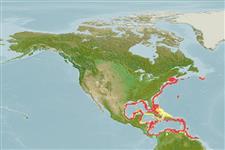Teleostei (teleosts) >
Aulopiformes (Grinners) >
Chlorophthalmidae (Greeneyes)
Etymology: Parasudis: Greek, para = side, in the side + Latin, sudis = esox, fish of the Rhine, cited by Plinius 9.15; it also means "stake" (Ref. 45335).
More on authors: Goode & Bean.
Environment: milieu / climate zone / depth range / distribution range
Ecology
Marine; demersal; depth range ? - 479 m (Ref. 47377), usually 133 - 181 m (Ref. 13608). Subtropical; 44°N - 7°N
Western Atlantic: southern New England, USA to the northern coast of Brazil, north of the Amazon. Northwest Atlantic: Canada (Ref. 5951).
Size / Weight / Age
Maturity: Lm ? range ? - ? cm
Max length : 25.0 cm TL male/unsexed; (Ref. 7251); common length : 22.5 cm SL male/unsexed; (Ref. )
Feed on fishes and sometimes sepia (Ref. 47377).
Life cycle and mating behavior
Maturity | Reproduction | Spawning | Eggs | Fecundity | Larvae
Robins, C.R. and G.C. Ray, 1986. A field guide to Atlantic coast fishes of North America. Houghton Mifflin Company, Boston, U.S.A. 354 p. (Ref. 7251)
IUCN Red List Status (Ref. 130435: Version 2024-1)
Threat to humans
Harmless
Human uses
Tools
Special reports
Download XML
Internet sources
Estimates based on models
Preferred temperature (Ref.
123201): 6.6 - 22.9, mean 18 °C (based on 38 cells).
Phylogenetic diversity index (Ref.
82804): PD
50 = 0.7500 [Uniqueness, from 0.5 = low to 2.0 = high].
Bayesian length-weight: a=0.00339 (0.00146 - 0.00784), b=3.13 (2.93 - 3.33), in cm total length, based on LWR estimates for this (Sub)family-body shape (Ref.
93245).
Trophic level (Ref.
69278): 4.2 ±0.73 se; based on food items.
Fishing Vulnerability (Ref.
59153): Low vulnerability (15 of 100).
